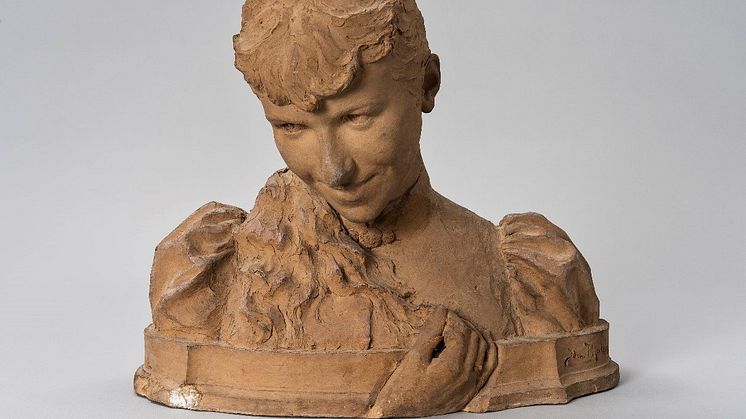
Press release -
New acquisition: Sculpted portrait by Ida Matton
Nationalmuseum has acquired a sculpted portrait in terracotta created in 1891 by Ida Matton. The bust depicts a young woman wearing a dress typical of the period, with a high collar and puff sleeves. The slight movement of the head, the model’s relaxed style and her dreamy gaze create the impression of a fleeting, momentary portrait. The work shows elements of both expressive naturalism and illusionism, reflecting trends in French sculpture at the time.
Ida Matton (1863–1940) was born in Gävle, Sweden. Her family ran a leather factory and were influential members of the town’s business community and social scene. With the financial means to acquire an education, Matton moved to Stockholm at a young age to train as a handicrafts teacher. She studied initially at Wallin’s art school before attending the technical college from 1882 to 1886 to become a sculptor, or “sculptress” as female practitioners were called in those days.
The late 19th century was a golden age of sculpture.The development of a new market in art, coupled with a need for public artworks to adorn the streets and squares of rapidly growing cities, had boosted demand for sculpture. Statues were no longer just monuments to the great and the good. The growing middle classes also wanted to decorate their homes with sculpture and applied art. Meanwhile, female artists were increasingly common in Sweden, as elsewhere, and many of these women chose a career as sculptors.
Like their female painter contemporaries, many Swedish “sculptresses” travelled to continental Europe, and Paris in particular, to pursue further studies. Among them was the 24-year-old Matton, one of many Scandinavians who attended the Académie Colarossi. There, female students had the same opportunity as their male counterparts to draw from life models, a cornerstone of any artistic education. Mattonwas soon writing to her brother in Sweden: “Now we have got down to work, and I am truly enjoying it. If you had any idea how much I have already learned! Every time I think back to the old technical college, I am mortified…” In Paris, Matton and her fellow sculptors were exposed to a new, freer aesthetic and had opportunities they had not had in Sweden to practise their craft. They also had the chance to exhibit their works. A mere year after her arrival, Matton made her debut to some acclaim at the annual Paris Salon.
Along with many of her colleagues, Matton was to remain in Paris for most of her life. She was deeply involved in efforts to create greater opportunities for female artists to work and exhibit on the same terms as their male counterparts. Matton had an extensive network of close female friends. Back home in Sweden, however, she found it hard to achieve a breakthrough and win recognition as an artist – perhaps because her works had a distinctive, somewhat academic salon style that was out of keeping with the trends of the time.
In the work recently acquired by Nationalmuseum, the audience encounters an unusually fresh and immediate portrayal of a young woman. With her hand, she plays with a lock of her hair, which is loosely gathered in a tassel at her neck, with a short, tousled fringe covering her brow. Her mouth carries the hint of a smile. The model’s unconventional posture and somewhat dreamy gaze create the impression of a fleeting, momentary portrait. The bust is finished at shoulder height with a decorative border suggestive of a base. However, the artist is flirting with illusionism here, since the model’s hand protrudes beyond the edge of the base. In Matton’s early works, like this portrait, we can see clear evidence of the French tradition established by sculptors such as Jean-Antoine Houdon and Jean-Baptiste Carpeaux, which was founded on technical virtuosity and elaborate illusionism. At the century’s end, new trends flourished in Paris, personified in sculpture by JulesDalouand AugusteRodin. The aesthetic was now even freer, with a desire to express emotions. This too can be clearly seen in this bust by Matton, which probably depicts someone from her circle of friends.
Nationalmuseum’s purchase of this work has been made possible by a generous donation from the Axel Hirsch Foundation. Nationalmuseum has no budget of its own for new acquisitions, but relies on gifting and financial support from private funds and foundations to enhance its collections of fine art and craft.
Press contacts
Linda Hinners, Sculpture Curator, linda.hinners@nationalmuseum.se, +46 8 5195 4404
Hanna Tottmar, Press Officer, press@nationalmuseum.se, +46 767 234232
Categories
Nationalmuseum is Sweden’s premier museum of art and design. The collections comprise older paintings, sculpture, drawings and graphic art, and applied art and design up to the present day. The museum building is currently under renovation and scheduled to open again in 2018. In the meantime, the museum will continue its activities through collaborations both in Sweden and abroad as well as temporary exhibitions at Nationalmuseum Design at Kulturhuset Stadsteatern in Stockholm. Nationalmuseum has partnerships with Svenska Dagbladet and the Grand Hôtel Stockholm, and acknowledges the support of FCB Fältman & Malmén.

